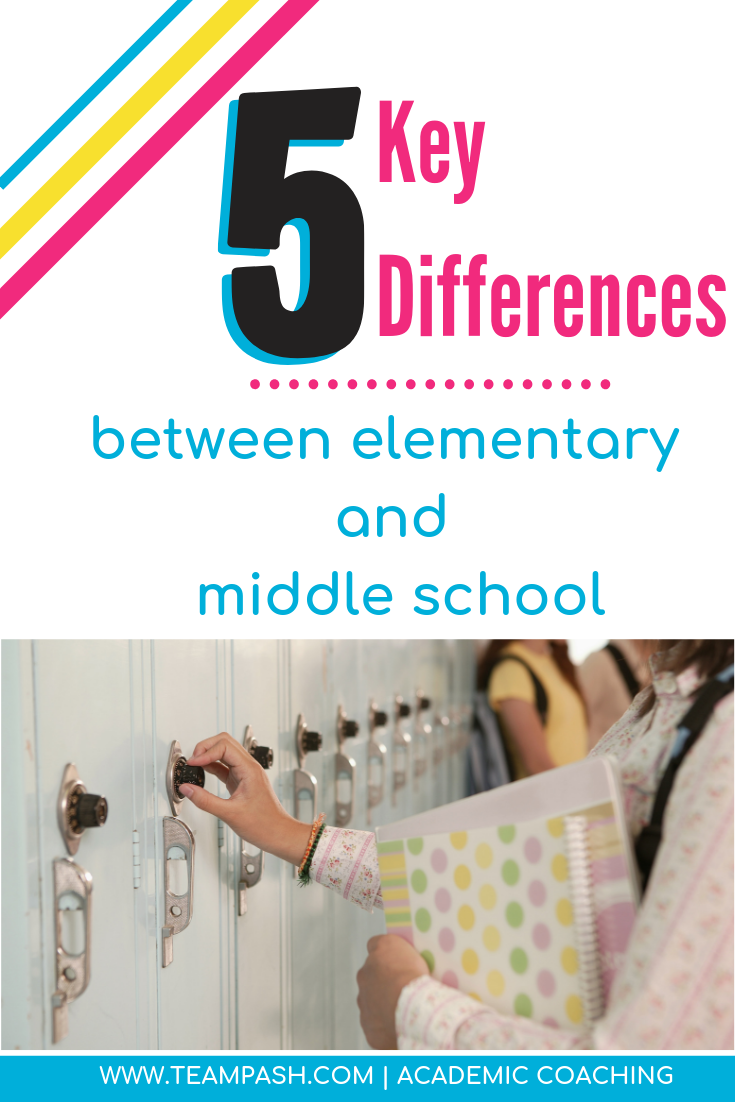The Differences Between Elementary and Middle School
How can you help your child with the transition from elementary school to middle school? The first thing parents can do is understand the main differences between the two school settings. Whether your child attends a private or public school, small or large, religion or not – there are trends that occur with the transition from 5th to 6th grade. Transiting from the former to the latter often comes with major changes in your child’s life.
As a result, getting informed about the differences between both levels of education can help you prepare your child for the new changes (and let’s be honest – it can prepare parents too).
The most common differences are found in the number of teachers, sizes of buildings, task number and difficulty, and increase in homework. In addition, there may be new resources available to your child such as a school counselor.
The Major Differences between Elementary School and Middle School
In the United States, elementary school typically refers to the grades of kindergarten stage through 5th grade. In the past, your child might have remained in elementary school until 6th grade, and advanced to junior high in 7th and 8th. Sadly, this system is less common today- many teachers I have spoken with, wish that elementary school extended into 6th grade to give children the time to mature and develop the skills required of them in middle school.
In elementary school, students typically have one main teacher and additional teachers for specials. Normally, the subjects taught in elementary school include Math, Social Studies, English, and Science. The students have the same class and classroom throughout the day. When they do change rooms, they do so with the same group. Many times, students are expected to work together; hence, teamwork is encouraged.
However, in middle school, the grades in focus are grades 6, 7, and 8. Students are older and approaching puberty. Generally, one subject is taught by one teacher and the students receive classes in different classrooms. The expectations become higher in middle school and students are expected to become more self-reliant.
The key differences between elementary school and middle school are as follows:
More Teachers
Unlike in elementary school where one teacher teaches all the subjects, several teachers are responsible for the subjects in middle school.
This implies that a child transiting to middle school should be prepared to encounter different teachers. More teachers means adapting to different styles, different rules and different personalities. Did I mention the word different?
This requires your child to be adaptable to change. If this is something they struggle with, starting the conversation now about how they might prepare for multiple rules and personalities of their teachers can help.
Bigger Buildings
Middle school is the link between elementary school and high school. Hence, students can expect to see bigger buildings which serve purposes such as classrooms, libraries, administrative blocks, and more.
Also, since students switch classrooms when it’s time to change a class, you’ll find less self-contained buildings (as are common in elementary school). In addition, if it is your child’s first time in a larger building - you might be introduced to portable classroom. These indicate that the school is so large,the school needs to bring in trailers that can accommodate the growing number of students,
How does your child feel about navigating the halls of a bigger school or a new building?
Middle School Brings more Expectations
Students in the 6th, 7th, and 8th grades are asked to perform at a higher level of development and task achievement. The tasks in middle school are often individualistic as opposed to the group work in elementary school; therefore, relying on the motivation of the individual student.
The downside with more responsibilities in middle school is that the weaknesses of struggling students become more noticeable. This is often where the perfectly organized student starts to flounder as their support systems are removed.
Presence of a School Counselor
One of the most remarkable aspects of middle school is the presence of a school counselor. Students in elementary school are monitored by their teacher. However, a teacher may not always be attentive to a child’s extra learning needs.
On the contrary, in middle school, students can approach the school counselor to discuss studying challenges and get guidance in their social and emotional struggles.
The downside is that your child might be one of hundreds of students on a school counselor’s caseload. It is important you teach your child to self-advocate and introduce yourself to the counselor in advance.
Have questions about this? Sign up for the Sixth Grade Success Roadmap here
Middle School Brings more Homework and Tests
Unlike elementary school, middle school comes with more homework. Teachers of each subject are expected to assess students regularly in order to track their performance.
Children who are moving from elementary school to middle school will obviously need homework help. So you can try to create time in your schedule to help your child complete their homework. If you feel this might be an area your child needs assistance in, consider setting up a parent consult for academic coaching.
The Bottom Line:
Life in middle school gets a little tougher and demanding. It’s a big shift from the basic life of elementary school. Students meet more teachers, do more homework, and face bigger challenges.
Nonetheless, when you’re familiar with the changes, you can help your child prepare for the transition. To get your step by step guide to handle the changes to middle school access the free Sixth Grade Success Roadmap by clicking here!
Rock on,
Marni Pasch
MA Counselor ED, ACC Academic Coach
Team Pasch Academic Coaching




